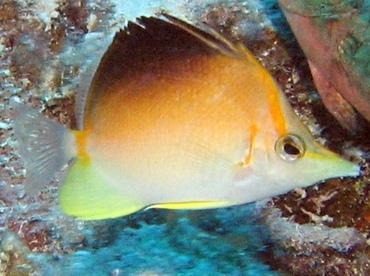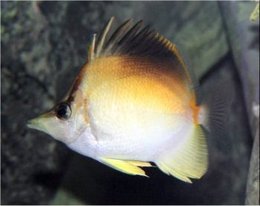Longsnout butterflyfish (Geography)
Contents
Longsnout butterflyfish
The longsnout butterflyfish (Prognathodes aculeatus) is a member of the butterflyfish family (Family Chaetodontidae) that lives on coral reefs in the Western Atlantic Ocean and the Caribbean Sea.
|
Scientific Classification Kingdom: Animalia (Animals) |
Physical Description
Longsnout butterflyfish range from five to ten centimeters in length. Their thin, oval bodies are white on their lower half, yellow on their upper half, and black on their dorsal fin. They derive their name from their long pointed mouths.
Distribution
They are found in the Western Atlantic from southern Florida to the Gulf of Mexico and the western Caribbean Sea, and as far south as Venezuela.
Habitat
They live on coral reefs at depths ranging from one to 90 meters.
Feeding Behavior
Longfin butterflyfish are generalist carnivores that feed on tubeworms, hydroids, and small crustaceans. They can use their long snouts to feed on the tube feet of urchins or the tentacles of tubeworms such as Christmas tree worms.
Behavior
This species generally lives alone, but can sometimes occur in pairs. They will retreat to the protection of the reef if they sense the presence of a predator.
Reproduction
Most reproduction occurs during the cooler winter months. They generally breed as monogamous pairs and they will spawn several evenings per week during the peak breeding season. Spawning occurs in the water column where fertilization occurs. After the eggs hatch, the larvae enter the pelagic stage until the larvae settle.
Associations
Unlike other butterflyfishes in the Caribbean, longsnout butterflyfish do not act as cleaners.
Conservation Status
The longsnout butterflyfish is not considered to be a species at risk.
References and Further Reading
- Encyclopedia of Life. 2011. Prognathodes aculeatus (Poey, 1860)
- P.Humann and N.Deloach.Butterflyfish. FishID
- P.Humann and N. Deloach (Editors), 1994. Reef Fish Identification: Florida, Caribbean, Bahamas. New World Publications, Inc. Jacksonville, FL. ISBN: 1878348078
- N.Deloach. 1999. Reef Fish Behavior, Florida, Caribbean, Bahamas. New World Publications, Inc. Jacksonville, FL. ISBN: 1878348280

